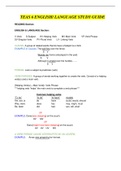TEAS 6 ENGLISH/ LANGUAGE STUDY GUIDE
READING Section:
ENGLISH & LANGUAGE Section:
V-Verb S-Subject HV-Helping Verb MV-Main Verb VP-Verb Phrase
SV-Singular Verb PV-Plural Verb LV- Linking Verb
CLAUSE- A group of related words that do have a Subject & a Verb
EXAMPLE of Clauses: The ball flew over the fence.
S V
Wanda ran home and played in the yard.
S V
Although I jumped over the hurdles…….
S V
PHRASE- Lack a subject & predicate (verb)
VERB PHRASES- A group of words working together to create the verb. Consist of a helping
verb(s) and a main verb.
[Helping Verb(s) + Main Verb]= Verb Phrase
***helping verb “helps” the main verb to complete a verb phrase***
Common helping verbs
“To be” “to do” “to have” modals
Am, are, is do have could, would, should
Was, were does has may, might, must
Be, been did had can, will, shall
VP
EXAMPLE: Dana [was sleeping] on the couch.
HV MV
VP
Dana [might have been sleeping] on the couch.
HV HV HV MV
A VERB PHRASE CAN BE INTERRUPTED BY AN ADVERB.
EXAMPLE: Arnav was preparing for his test.
, Arnav was not preparing for his test.
Arnav was eagerly preparing for his test.
Arnav was not eagerly preparing for his test.
ADVERB- Modifies a verb, adjective, another adverb, determiner, noun phrase, clause, or
sentence.
LINKING VERBS-Linking verbs connect the subject of the verb to additional information about
the subject (or state of being). A linking verb is a verb that links (connects) the subject of the
sentence to information about that subject. Linking verbs include the verbs: be, become, and
seem. Examples: He is a minister. She seems very nice. The night became darker.
EXAMPLE: Jermaine was washing his car.
S LV V
Fahim may have arrived this morning.
S LV LV V
Rachel could have been practicing in the backyard.
S LV LV LV V
Present Tense Past Tense
I am we are I was we were
You are you (y’all) are you (y’all) were you (y’all) were
He is, she is, it is they are he was, she was, it was were
VERB- Action in a sentence or state-of-being.
COMPOUND PREDICATES/ VERBS- 2 or more Predicates (verbs) in a sentence
EXAMPLE: Tyler read and studied.
Tyler read, studied and slept.
-A Note on Three Problem Verbs-
Three common irregular verbs that confuse many writers are be, do, and have. Here are the
correct present tense and past tense forms of these three verbs.
Present Tense Past Tense
Be I am we are I was we were
You are you are you were you were
He, she, it is they are he, she, it was they were
Do I do we do I did we did
You do you do you did you did
He, she, it does they do he, she, it did they did
, Have I have we have I had we had
You have you have you had you had
He, she, it has they have he, she, it had they had
SIMPLE & COMPLETE SUBJECTS & PREDICATES/ VERBS:
SIMPLE SUBJECT SIMPLE PREDICATE/ VERB
Dog Barked
COMPLETE SUBJECT COMPLETE PREDICATE/ VERB
A cute little dog with a purple collar barked very loudly at the mailman.
SUBJECT- Noun in a sentence that is doing the action.
COMPOUND SUBJECT- 2 or more Subjects in a sentence.
EXAMPLE: Billy and Kim ate pizza.
Billy, Kim, and Sam ate pizza.
COMPOUND SUBJECTS USING “OR”
When “or” combines 2 subjects, use the subject closest to the verb to determine whether the
verb is singular or plural.
EXAMPLE: The waiters or the manager serves dinner to the guests.
PV
The managers or the waiters serve dinner to the guests.
SV
Your teacher or your parents are making sure you study.
PV
Your parents or your teacher is making sure you study.
SV
What three ingredients does a complete sentence need?
A) Subject
B) Verb
C) Complete thought
Define a “Fragment”: An incomplete sentence; A group of words that does not express a
complete thought.
EXAMPLE: on the baseball field
could have slept later
the boy in the baggy pants
after we left the pool
What are the two ways to fix a fragment?




